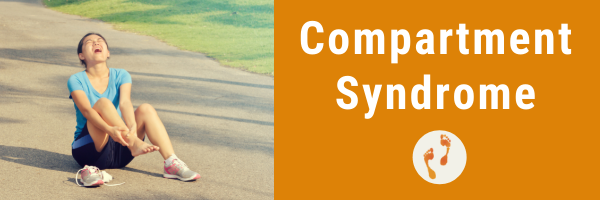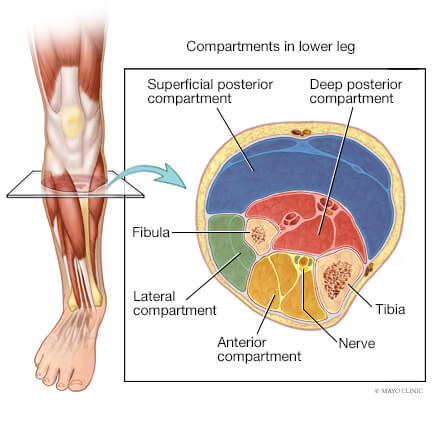Compartment Syndrome

Compartment syndrome refers to pain in the lower leg or foot caused by an elevation in pressure in one of the four compartments of the lower leg, or in the foot. Think of a leg or foot like a mandarin, with each piece of mandarin being its own compartment, surrounded by the mandarin skin to house the mandarin flesh. This is exactly what it’s like here – except each of the compartments houses muscles, blood vessels and nerves, and is surrounded by a thin tissue sheath to keep each compartment firmly enclosed.
Compartments already have a snug fit, so when the pressure within a compartment is increased from bleeding within the compartment, swelling, or something else – pain starts, and the constant pressure can compromise the muscles, nerves and vessels and lead to a cascade of dangerous and unwanted side effects. The severity of these side effects are directly related to whether you have an acute case or a chronic case of compartment syndrome.
Acute Compartment Syndrome Is A Medical Emergency
 Acute compartment syndrome is a sudden onset of pressure in a compartment that is usually linked to traumatic accidents to the leg or foot, crush injuries, burns, severe and sudden sports injuries, and more. It is a medical emergency that requires immediate surgery to decompress the compartment and allow the muscles, nerves and vessels to regain blood flow before they have been cut off long enough to cause tissue death.
Acute compartment syndrome is a sudden onset of pressure in a compartment that is usually linked to traumatic accidents to the leg or foot, crush injuries, burns, severe and sudden sports injuries, and more. It is a medical emergency that requires immediate surgery to decompress the compartment and allow the muscles, nerves and vessels to regain blood flow before they have been cut off long enough to cause tissue death.
If you suspect you have acute compartment syndrome, experience increasing foot or leg pain following a notable injury or event, and the pain is intense or exceeds the level you’d typically expect for the injury you sustained, have your leg assessed by your GP to rule out this condition. You can also look out for:
- Stretching the toes or the foot in an up and down motion passively may cause excruciating pain
- Low blood pressure
- Sensory changes which include numbness and tingling
- Weakness in the foot and leg muscles during movement as a result of temporary paralysis of the muscles that are within the compartment
- A swollen tense muscle compartment so that when you touch it, feels rock hard
Chronic Exertional Compartment Syndrome
In chronic compartment syndrome, the elevated pressure within the muscle compartment typically occurs gradually as a result of exercise, with the symptoms coming on gradually and worsening until the pain is severe enough that a person is no longer able to keep exercising. Reasons for the elevated pressure are often associated with muscle swelling, which can occur from overtraining (going too hard, too fast) and from biomechanical imbalances of the foot and leg – like when one muscle compartment has to work harder to compensate for weakness in another muscle group.
Chronic compartment syndrome can come and go, starting when a person is exercising and settling down a while after they stop the activity – this can take time. People often find that there are certain types of exercise that may bring on the symptoms, such as running, while low-impact exercise such as swimming or walking doesn’t produce any symptoms. You may notice:
- Gradually growing pain in a specific muscle compartment in the lower leg (often the anterior compartment at the front of the lower leg, which may be mistaken for shin splints)
- The muscle compartment may feel tight or swollen
- There may be some numbness or tingling in the lower leg or foot
- There is often no residual pain the next day, until symptoms restart when strenuous exercise is restarted
Treatment
Before you can get in to see a podiatrist, you can manage your symptoms by avoiding the specific activities that produce the pain.
Treating compartment syndrome starts with an exam and detailed history to diagnose the condition and rule out any other causes of lower leg pain like shin splints. Next, we identify the likely causes of your overuse of the painful muscle compartment. It may be related to your gait, foot posture, muscle weakness or tightness, your training schedule, footwear and many more. We’ll then treat the factors we can control, helping to prevent overuse while you stay active, which may involve:
- Orthotics to adjust the way you load muscles and tissues, and your foot and leg biomechanics
- Foot mobilisation therapy to address dysfunctional movement patterns that may be contributing to overloading the muscle compartment
- Stretching and strengthening program to correct muscle imbalances
- Gait retraining to optimise movement and muscle engagement
- Footwear assessment to ensure your shoes are supporting healthy foot function
If you’re unsure whether your leg pain is being caused by compartment syndrome or something else, book an assessment with our podiatrists. We’ll diagnose the cause of your pain and refer you for any imaging needed to confirm your diagnosis.
FAQs
Can Compartment Syndrome affect multiple compartments in the body?
Hypothetically yes, compartment syndrome can affect multiple compartments in the body, although it is most commonly associated with the lower leg, especially the front of the shins. It can also occur in the forearm, hand, foot, thigh, or other areas where muscles are compartmentalised.
Are there any specific exercises or physical therapy techniques that can help with the management of Compartment Syndrome?
Physical therapy techniques may be helpful in the management of Compartment Syndrome. However, the specific exercises or techniques would depend on the underlying cause and individual circumstances. Your podiatrist will guide you through exercises aimed at improving muscle flexibility, strength, and overall function while taking precautions to prevent further compartmental pressure.
Can Compartment Syndrome be managed or improved without surgery?
Acute cases of Compartment Syndrome, especially those caused by trauma, often require immediate surgical intervention to relieve the pressure within the affected compartment. However, in chronic cases (as is the majority that we see and help manage), surgery is rarely required and this condition is typically managed completely conservatively.
What does the surgical treatment for Compartment Syndrome involve?
The surgical treatment for Acute Compartment Syndrome typically involves a procedure called a fasciotomy. During a fasciotomy, the surgeon creates incisions in the affected compartment’s fascia (connective tissue) to release the pressure and allow the muscles and tissues to expand. In some cases, additional procedures, such as tissue grafting or wound closure techniques, may be necessary.


